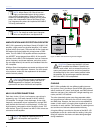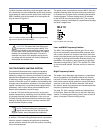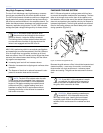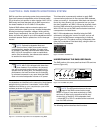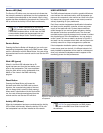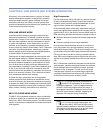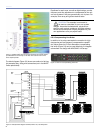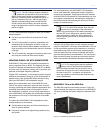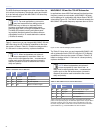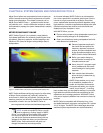
20
CHAPTER 5
Mid to Low Frequencies
For the mid to low frequencies, line arrays must be coupled
to narrow their vertical coverage and project mid and low
energy to the far field. The directional control of the array is
achieved when the length of the array is similar to or larger
than the wavelength of the frequencies being reproduced
by the array. As frequencies get lower and wavelengths get
longer, the number of cabinets has a critical effect while the
splay angle between cabinets has little effect since the total
length is not modified substantially. The number of array
elements, however, is important: The more MILO 120 loud-
speakers used, the more directional the vertical beamwidth
becomes at mid to low frequencies.
Adjusting Line Array Coverage
Regardless of the needs of your system design, fine-tuning
coverage for a MILO 120 curvilinear array will be dependent
on three factors:
■ Number of Array Elements. Determining the number
of elements to use is critical: The number of elements
drastically affects the uniformity of coverage of both
SPL and frequency response.
■ Vertical Splay Angles. Changing the splay angles
between cabinets has a significant impact on vertical
coverage, with the result that narrower vertical splay
angles produce a higher Q vertical beamwidth, while
wider splay lowers the Q at high frequencies.
■ Horizontal Coverage. Horizontal coverage for a single
array of MILO 120 can be considered constant regard-
less of the number of array elements or the angles
between them.
TIP: The angle between two or more line
arrays in the horizontal plane can also be
changed to meet additional design requirements (for
example, wall reflections).
Given these factors, designing and deploying a line array
system will typically have the following objectives:
■ Even horizontal and vertical coverage
■ Uniform SPL
■ Uniform frequency response
■ Sufficient SPL for the application
With two different technologies (low-frequency cone radia-
tors and high-frequency wave guides) built into each MILO
120 cabinet, achieving these goals becomes a multi-step
process, with different strategies for the lower and higher
frequencies for long throws and short throws.
NOTE: MAPP Online, covered in greater
detail later in this chapter and in Chapter 6,
is the tool of choice to enable you to make ac-
curate and comprehensive predictions for optimal
coverage(s) during the design phase.
USING MILO 120 AS DOWNFILL FOR MILO
CURVILINEAR ARRAYS
MILO 120 acoustical characteristics and rigging are de-
signed to facilitate seamless integration with MILO when
used as downfill in MILO curvilinear arrays. Understanding
the differences and similarities between the two loudspeak-
ers is very important for fine-tuning system coverage. For a
combined MILO/MILO 120 array, the design will be depen-
dent on three factors:
■ Number of Array Elements. Determining the number
of elements of each type to use is critical: The number
of elements drastically affect the uniformity of cover-
age of both SPL and frequency response. The number
of long-throw elements (MILO) and downfill (MILO 120)
needs to be carefully selected.
■ Vertical Splay Angles. Changing the splay angles
between cabinets has a significant impact on vertical
coverage, with the result that narrower vertical splay
angles produce a higher Q vertical beamwidth and lon-
ger throw in the top elements (MILO), while wider splay
lowers the Q at high frequencies for wider coverage on
the lower elements (MILO 120).
■ Horizontal Coverage. Horizontal coverage needs to
be divided in two sections. The top section covered by
MILO (90 degrees) and the lower section covered by
MILO 120 (120 degrees). These two sections can be
considered fairly constant regardless of the number of
array elements on each section or the angles between
them.
With two different technologies (low-frequency cone radia-
tors and high-frequency wave guide) built into each cabi-
net and two different cabinet types (MILO and MILO 120),
achieving design goals becomes a multi-step process, with
different strategies for the lower and higher frequencies for
long and short throws.
NOTE: MAPP Online is the tool of choice to
enable you to make accurate and compre-
hensive predictions for optimal coverage(s) during
the design phase.



